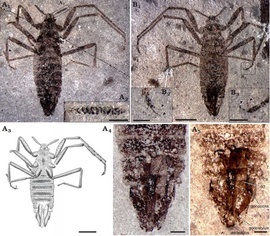Saurophthirus laevigatus: A new species of Flea from the Early Cretaceous Yixian Formation of Liaoning Province, China.
[sciencythoughts.blogspot.com]
Siphonaptera, commonly known as Fleas, are one of the widely known blood-sucking ectoparasitic Insects, comprising more than 2500 described species in 16 extant families. Up to now, the fossil Siphonaptera contain 16 species in five families from Cainozoic amber and Mesozoic compression fossils. All Cainozoic Fleas have been placed in two families, the Ctenophthalmidae and Pulicidae, while all Mesozoic Fleas, grouped in three families, the Pseudopulicidae, Saurophthiridae, and Tarwiniidae, which together form an extinct superfamily, the Saurophthiroidea, comprising nine species within five genera. Saurophthirus longipes, an unusual insect from the Early Cretaceous Zaza Formation of Baissa in Siberia, was described by Arnold Ponomarenko in 1976. He reported that its similarities with Fleas are piercing-sucking proboscis and soft distensible abdomen. A family of Saurophthiridae was established by Ponomarenko ten years later in 1986, including only this species. Another species of this family, Saurophthirus exquisitus, was described in 2013, based on three specimens, from the Early Cretaceous Yixian Formation of Liaoning Province, China, and it was suggested that the Saurophthiridae represent a transitional group from basal to extant Fleas. These fossil Fleas display some features seen in crown Fleas but are still considerably different from extant Fleas in many morphological characters, e.g., the absence of pronotal and genal ctenidia (comblike structures) on the body, the lack of the uniquely modified jumping hind legs, distinct ctenidia on the tibiae, more developed eyes, antennae with more than 15 segments, absence of laterally compressed abdomen, presence of medium body size, swollen hind coxae and partially extended male genitalia. These features indicate that Saurophthirus is more closely related to modern Fleas than to the Cretaceous genera Pseudopulex and Tarwinia.

Enjoy being online again!
Welcome to the community of good people who base their values on evidence and appreciate civil discourse - the social network you will enjoy.Create your free account
4 comments
Feel free to reply to any comment by clicking the "Reply" button.Recent Visitors 24
Ritchie
PA, USA
EyesThatSmile
Gulf Coast Of Texas,
Novelty
CA, USA
Triphid
Broken Hill,
TimeOutForMe
Johannesburg,
Photos 292 More
Posted by JoeBKite-like structures in the western Sahara Desert.
Posted by TriphidAn Aussie Indigenous Message Stick.
Posted by TriphidIndigenous Australian Aboriginal Rock art dated somewhere between 20 and 30 thousand years old.
Posted by TriphidIndigenous Australian Aboriginal Rock art dated somewhere between 20 and 30 thousand years old.
Posted by TriphidIndigenous Australian Aboriginal Rock art dated somewhere between 20 and 30 thousand years old.
Posted by TriphidIndigenous Australian Aboriginal Rock art dated somewhere between 20 and 30 thousand years old.
Posted by JoeBDortoka vremiri: A new species of Dortokid Turtle from the Late Cretaceous of the Hațeg Basin, Romania.
Posted by JoeBThe Cabeço da Amoreira burial: An Early Modern Era West African buried in a Mesolithic shell midden in Portugal.
Posted by JoeBMusivavis amabilis: A new species of Enantiornithine Bird from the Early Cretaceous Jehol Biota of northeastern China.
Posted by JoeBTorosaurus in Canada.
Posted by JoeBStone tools from the Borselan Rock Shelter, in the Binalud Mountains of northeastern Iran.
Posted by JoeBDating the Lantian Biota.
Posted by JoeBBashanosaurus primitivus: A new species of Stegosaur from the Middle Jurassic of Chongqing Municipality, China.
Posted by JoeBDetermining the time of year when the Chicxulub Impactor fell.
Posted by JoeBSão Tomé and Príncipe: Possibly the last country on Earth never to have been visited by a working archaeologist.
Posted by JoeBMambawakale ruhuhu: A new species of Pseudosuchian Archosaur from the Middle Triassic Manda Beds of Tanzania.







